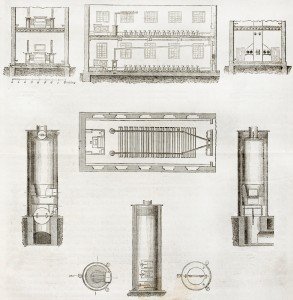History of Air Conditioning – How AC Technology Existed
The history of air conditioning is fascinating. To many people, running their air-conditioner during the summer is as much of a tradition as drinking lemonade and cutting the grass. Obviously though it wasn’t always that way. The popularity of watering holes in the early 1900’s was at an all-time high because taking a dip was the only legitimate way to cool off on hot days. Even in the 1930’s and 40’s only the rich people owned air-conditioners, and they were the ones the least likely to work up a sweat! Eventually the big bulky window air-conditioners were the norm but they were often noisy and a complete drain on the power grid. Today it seems that the air-conditioning technology has come full circle as the units on the market are quiet, energy-efficient, inexpensive, and easy to install.
That being said, let’s take a closer look at the history of air conditioning.
1758: Franklin and Hadley Freeze Water
Benjamin Franklin (Writer, Inventor and Scientist) and a Cambridge University Professor (John Hadley) discovered that they could freeze water by evaporating highly volatile liquids such as alcohol.
1848: Gorrie Files Patent for Machine that Manufactures Ice
In 1941, Dr. John Gorrie commenced his research to manufacture an ice-making machine at the Florida hospital where he worked. Over several years, he designed a steam-powered machine that extracts heat from water, which in turn makes ice as it was cooled below freezing. Gorrie imagined that his invention would cool buildings all over the world, but his dream died when he was unsuccessful in securing financial backing. Modern refrigeration descends from Gorrie’s principles.
1902: Willis Carrier Invents the First Modern Air Conditioner
Those familiar with the Carrier Air Conditioner Company will recognize the name of Willis Carrier, the father of air-conditioning as we know it. Willis Carrier invented the first a/c, calling it the “Apparatus for Treating Air”, for the Sackett-Wilhelms Lithographing Company. The publishing company needed a way to keep the room temperature cool and the humidity down so the paper wouldn’t wrinkle and the ink would stay aligned during production runs. Carrier’s machine blows air over cold coils and into the room creating a comfortable work area. When word spread concerning this innovation, companies started lining up to bide for Carrier’s services.
1906: Stuart Cramer Conditions the Air
The first term of ‘air-conditioning’ is used in 1906 by Stuart Cramer a mill engineer in North Carolina. Cramer added a ventilating device to Carrier’s basic design that would add water vapor into the air. The design is basically contradictory of what air-conditioners do today as Cramer’s a/c actually added humidity to the air so that yarn was easier to spin and more durable.
1914: Not Just For Factories Anymore
Conceivably, a device that keeps factories and mills cool would be a welcome addition to individuals struggling to deal with hot temperatures in their homes. In 1914 that became a reality but much like the first computers that took up a whole room, the first home a/c was 7 feet high, 6 feet wide, and 20 feet long (and people complain how heavy their window air conditioner is today!). The unit was installed in the mansion of a Minneapolis millionaire and was likely never used since it was a ‘spare house’ that nobody ever lived in.
1931: First Window Air Conditioners As They’re Known Today
Having the foresight to understand that a 7′ X 6′ X 20′ air conditioner just wasn’t conceivable, two inventors came up with the design for an individual room a/c that sits on a window ledge. The incarnate principals of that first window air conditioner are still in use to this day and for much less than the $10,000 to $50,000 price tag of back then.
1939: Air Conditioning Comes to Cars
Cool air finally came to automobiles in 1939 but they were anything but convenient to operate. The dashboard controls as they’re recognized today came down the line but in order to turn on the first a/c’s drivers had to stop the engine and disconnect a compressor belt underneath the hood.
1942: Power Plants Do Their Part
With more and more people purchasing air-conditioners for their homes and business, the United States built the first “summer peaking” power plant that was effectively designed simply to handle all the excess electrical loads of air-conditioners being run in the summer.
1950’s ERA: Air-Conditioners Become Mainstream
After World War II an economic boom surged that made it easier to manufacture air-conditioners, which in turn made them more affordable. This led to air-conditioners going from being a luxury item to a household norm. As a result, in 1953 over 1,000,000 air-conditioners are sold.
1970’s ERA: Central Air Conditioners Hit the Market
The next big evolution in the life of air-conditioning is the advent of the central air units. Whereas window air-conditioners were designed to cool only one room, central a/c became popular because it cycled chilled air through duct work into any vented area in the house. The central air was generally quieter because the condenser and compressor units sat outside and the main noise was from an air handler located in a utility room or garage.
1990’s ERA: Environmental Worries Challenge Air Conditioners
With central air conditioners being around for 20 years by the mid 1990’s, it came as a shocking blow when it was discovered that the refrigerant used, Freon-12, was contributing to the depletion of the ozone layer. Several companies banned the refrigerant and major a/c manufacturers scampered to develop refrigerants that are more environmentally friendly.
2000’s ERA: Smart Technologies Advance Air Conditioners Even Further
For the most part the same basic components that operated the first central air systems remained in place in modern times. One thing that changed was how those systems were controlled. With the advent of smart phones and programmable thermostats, people can now monitor their HVAC systems from across the globe as well as set their units to turn on and off at specific times of day such as when returning from work or while sleeping. These technologies are considered not only convenient, but have also contributed to increased energy efficiency as the systems run only when they are needed.
The History of Air Conditioning: What does the future hold?
The future of air-conditioning units is largely unknown. There are some next-level concepts in place such as cooling with sound-waves and using refrigeration free cooling methods which will probably be here sooner rather than later. It’s hard to predict though, after all for all we know we may be living in an air-conditioned dome in a decade or so.
I hope you enjoyed this article about the history of air conditioning.
Other articles you many enjoy:

